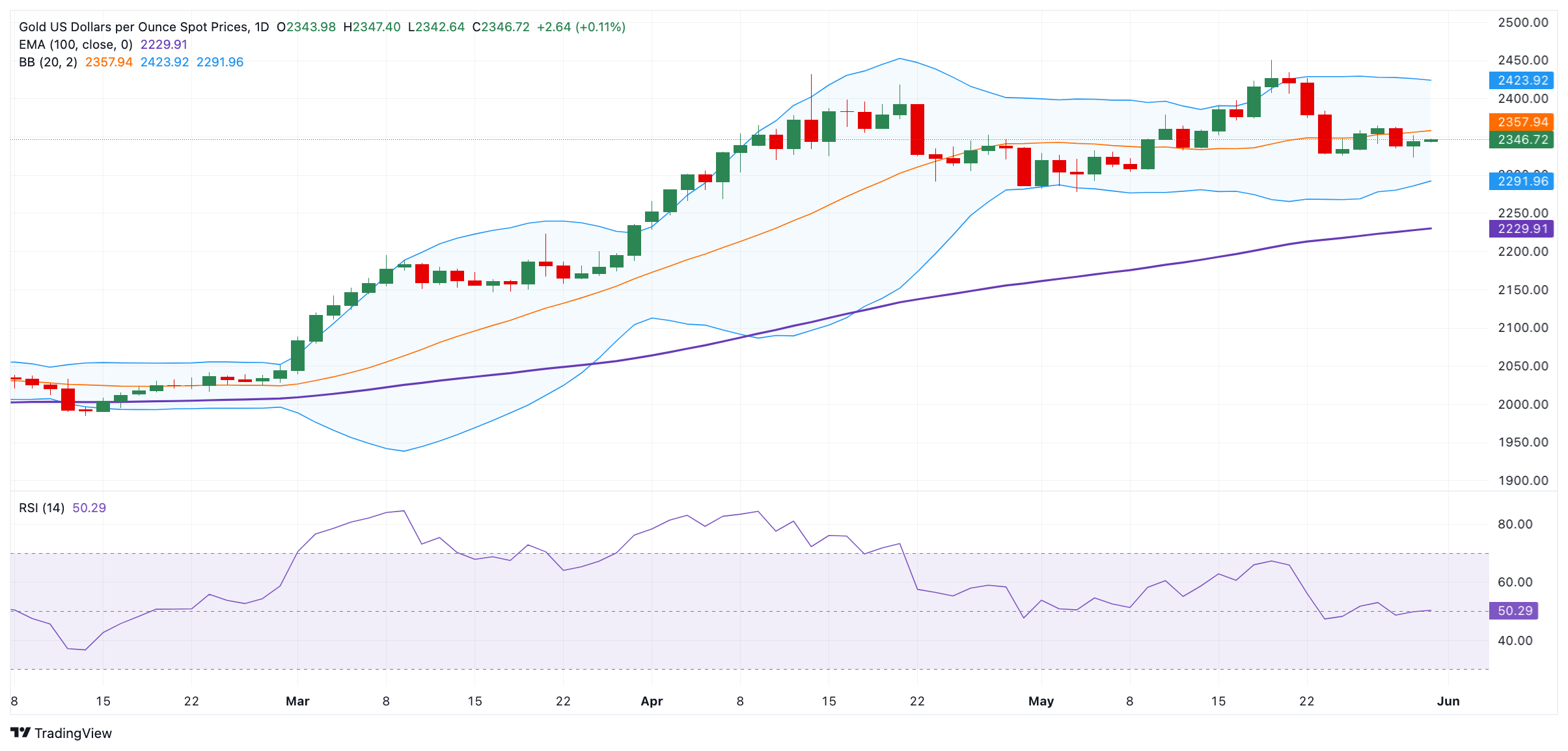Gold price post modest gains, all eyes on US PCE data

- Gold price trades with a mild positive bias on Friday.
- The weaker USD and decline of US yields support the yellow metal.
- Investors will take more cues from the US April PCE inflation data, which is due on Friday.
Gold price (XAU/USD) advances modestly on Friday on the back of the softer US dollar (USD) and lower US yields. Traders place higher bets that the Federal Reserve (Fed) will cut the interest rate this year after the recent weaker US GDP data. Furthermore, the geopolitical risks and conflicts in the Middle East might boost the precious metal as it is perceived as a traditional safe-haven asset.
Later on Friday, gold traders will keep an eye on the US April Core Personal Consumption Expenditures Price Index (Core PCE), the Fed’s preferred inflation measure. The Core PCE figure is projected to show an increase of 0.3% MoM and 2.8% YoY in April. In case of the hotter-than-expected inflation data, this might provide some support to the Greenback and cap the upside for gold price.
Daily Digest Market Movers: Gold price rises amid geopolitical risks and weaker US GDP
- Israel is in effective control of Gaza’s entire land border after taking control of a buffer zone along the border with Egypt, Israel’s military has said, a move that may complicate its ties with Egypt, per the Guardian.
- The second estimate of US Gross Domestic Product (GDP) showed the economy expanded at an annualized pace of 1.3% in Q1 from 1.6% in the previous reading, in line with market expectations.
- The US weekly Initial Jobless Claims for the week ending May 25 rose to 219K from the previous week of 216K, above the market consensus of 218K.
- Chicago Fed President Austan Goolsbee said on Thursday that housing inflation remains a key sticking point in price growth and that the US labor market remains quite strong.
- Atlanta Fed President Raphael Bostic stated that central bankers are unlikely to deliver an interest rate cut in July amid signs that inflation progress has slowed.
- New York Fed President John Williams noted that inflation is still too high, but he is confident it will start decelerating later this year, per CNBC.
Technical analysis: Gold price remains positive on the daily chart
The gold price posts modest gains on the day. Technically, the yellow metal maintains the bullish picture as it is above the key 100-day Exponential Moving Average (EMA). Nonetheless, the 14-day Relative Strength Index (RSI) hovers around the 50-midline, suggesting a lack of direction for gold price and further consolidation looks favourable.
The upper boundary of the Bollinger Band near $2,425 acts as an immediate resistance level for precious metal. Any follow-through buying will see a rally to the all-time high of $2,450 en route to the $2,500 psychological barrier.
On the other hand, the key contention level will emerge at the $2,290–$2,300 region, portraying the lower limit of the Bollinger Band and the round mark. A decisive break below this level will drag the yellow metal lower to the 100-day EMA of $2,230.
US Dollar price this week
The table below shows the percentage change of US Dollar (USD) against listed major currencies this week. US Dollar was the weakest against the Swiss Franc.
| USD | EUR | GBP | CAD | AUD | JPY | NZD | CHF | |
| USD | 0.27% | 0.10% | 0.06% | -0.17% | -0.04% | -0.09% | -1.16% | |
| EUR | -0.27% | -0.17% | -0.22% | -0.44% | -0.32% | -0.35% | -1.44% | |
| GBP | -0.10% | 0.17% | -0.05% | -0.28% | -0.15% | -0.20% | -1.27% | |
| CAD | -0.05% | 0.20% | 0.06% | -0.22% | -0.10% | -0.15% | -1.23% | |
| AUD | 0.14% | 0.42% | 0.24% | 0.20% | 0.10% | 0.09% | -1.01% | |
| JPY | 0.05% | 0.31% | 0.16% | 0.07% | -0.17% | -0.02% | -1.12% | |
| NZD | 0.11% | 0.37% | 0.21% | 0.17% | -0.08% | 0.07% | -1.05% | |
| CHF | 1.13% | 1.42% | 1.25% | 1.20% | 0.96% | 1.11% | 1.06% |
The heat map shows percentage changes of major currencies against each other. The base currency is picked from the left column, while the quote currency is picked from the top row. For example, if you pick the Euro from the left column and move along the horizontal line to the Japanese Yen, the percentage change displayed in the box will represent EUR (base)/JPY (quote).
Fed FAQs
Monetary policy in the US is shaped by the Federal Reserve (Fed). The Fed has two mandates: to achieve price stability and foster full employment. Its primary tool to achieve these goals is by adjusting interest rates. When prices are rising too quickly and inflation is above the Fed’s 2% target, it raises interest rates, increasing borrowing costs throughout the economy. This results in a stronger US Dollar (USD) as it makes the US a more attractive place for international investors to park their money. When inflation falls below 2% or the Unemployment Rate is too high, the Fed may lower interest rates to encourage borrowing, which weighs on the Greenback.
The Federal Reserve (Fed) holds eight policy meetings a year, where the Federal Open Market Committee (FOMC) assesses economic conditions and makes monetary policy decisions. The FOMC is attended by twelve Fed officials – the seven members of the Board of Governors, the president of the Federal Reserve Bank of New York, and four of the remaining eleven regional Reserve Bank presidents, who serve one-year terms on a rotating basis.
In extreme situations, the Federal Reserve may resort to a policy named Quantitative Easing (QE). QE is the process by which the Fed substantially increases the flow of credit in a stuck financial system. It is a non-standard policy measure used during crises or when inflation is extremely low. It was the Fed’s weapon of choice during the Great Financial Crisis in 2008. It involves the Fed printing more Dollars and using them to buy high grade bonds from financial institutions. QE usually weakens the US Dollar.
Quantitative tightening (QT) is the reverse process of QE, whereby the Federal Reserve stops buying bonds from financial institutions and does not reinvest the principal from the bonds it holds maturing, to purchase new bonds. It is usually positive for the value of the US Dollar.
Information on these pages contains forward-looking statements that involve risks and uncertainties. Markets and instruments profiled on this page are for informational purposes only and should not in any way come across as a recommendation to buy or sell in these assets. You should do your own thorough research before making any investment decisions. FXStreet does not in any way guarantee that this information is free from mistakes, errors, or material misstatements. It also does not guarantee that this information is of a timely nature. Investing in Open Markets involves a great deal of risk, including the loss of all or a portion of your investment, as well as emotional distress. All risks, losses and costs associated with investing, including total loss of principal, are your responsibility. The views and opinions expressed in this article are those of the authors and do not necessarily reflect the official policy or position of FXStreet nor its advertisers. The author will not be held responsible for information that is found at the end of links posted on this page.
If not otherwise explicitly mentioned in the body of the article, at the time of writing, the author has no position in any stock mentioned in this article and no business relationship with any company mentioned. The author has not received compensation for writing this article, other than from FXStreet.
FXStreet and the author do not provide personalized recommendations. The author makes no representations as to the accuracy, completeness, or suitability of this information. FXStreet and the author will not be liable for any errors, omissions or any losses, injuries or damages arising from this information and its display or use. Errors and omissions excepted.
The author and FXStreet are not registered investment advisors and nothing in this article is intended to be investment advice.




